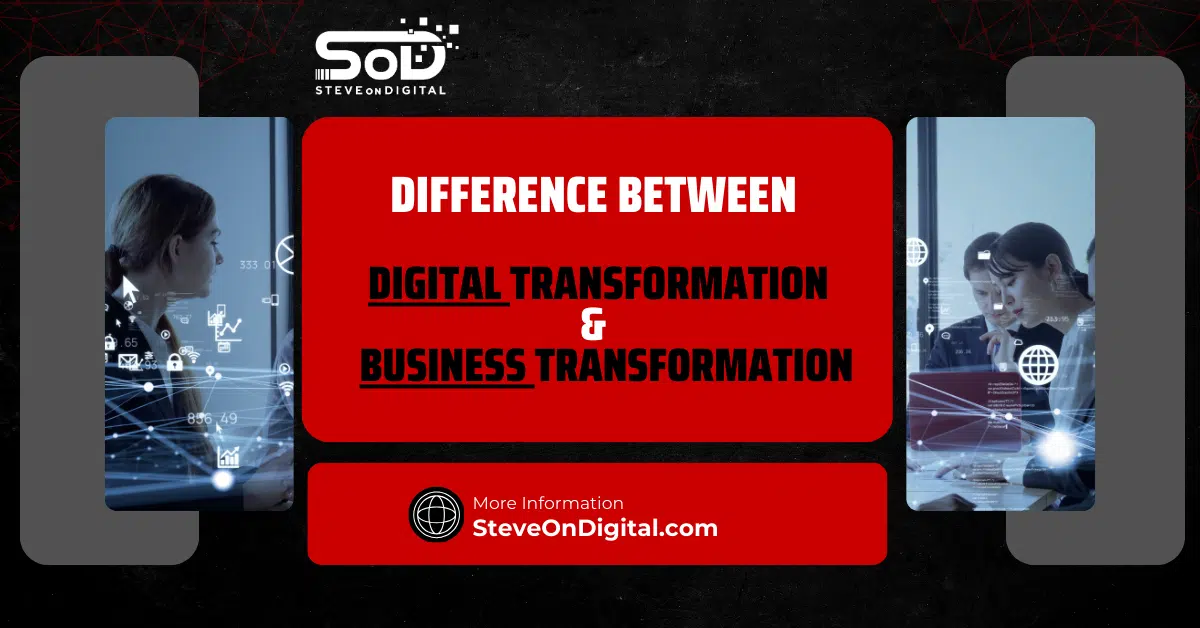The impact of the technology platform on small businesses is profound. Technology platforms play a crucial role in empowering small business by enhancing operations, improving customer service, and driving growth.
As a small business owner, I understand the need to stay ahead of technological trends. This article explores how technology affects small businesses and provides insights to help owners navigate the digital landscape effectively. The Chamber Technology Engagement Center (C_TEC), in collaboration with Teneo Research, conducted a nationwide survey to demonstrate the benefits of technology for small businesses.
I’m Steve, a digital transformation expert with a strong background in computer science education electrical engineering, an MBA, and a master’s in Project Management. I excel at helping SMEs navigate the digital landscape with practical insights. Let’s begin!
Evolution Of Technology In Small Businesses
Historical Context
The adoption of technology in small businesses in modern world has been driven by technological advancements and has been a gradual but significant process. From the early days of using basic accounting software to today’s advanced artificial intelligence systems, the evolution is remarkable. Key milestones include the introduction of personal computers in the 1980s, the internet boom in the 1990s, and the mobile revolution in the 2000s. These advancements have transformed how small businesses operate, making processes more efficient and accessible.
| Era | Key Technological Milestone | Impact on Small Businesses |
|---|---|---|
| 1980s | Introduction of Personal Computers | Improved productivity and data management |
| 1990s | Internet Boom | Enhanced communication and access to global markets |
| 2000s | Mobile Revolution | Increased mobility and remote work capabilities |
| 2010s | Cloud Computing | Scalable data storage and cost-effective solutions |
| 2020s | Artificial Intelligence and IoT | Automation, advanced analytics, and improved decision-making |
Current Landscape
Currently, small businesses are leveraging a diverse range of technologies to stay competitive. Digital transformation strategies are being adopted to enhance operational efficiency and customer engagement. The small business ecosystem has been significantly impacted by technology platforms, driving economic success and enabling businesses to thrive with digital tools. Technology platforms play a critical role in helping small businesses navigate challenges such as workforce shortages and inflation. High-speed broadband access and instant messaging have revolutionized communication, while online stores have expanded market reach. Commonly used technologies include digital tools for project management, cloud storage for data management, and AI for customer service. The integration of these technologies has created a dynamic and innovative small business landscape.
Benefits Of Technology For Small Businesses
| Benefit | Description | Examples |
|---|---|---|
| Increased Efficiency | Streamlines operations, reduces manual tasks, and minimizes errors. | Trello, Asana, QuickBooks |
| Enhanced Communication | Improves real-time communication and collaboration among team members. | Slack, Microsoft Teams, Zoom |
| Competitive Advantage | Helps businesses stay ahead of competitors and reach a broader customer base. | Shopify, AI-powered customer service tools |
Increased Efficiency
One of the most significant benefits of technology for small businesses is increased operational efficiency. Digital tools includes small business owners streamline operations, reducing the need for manual tasks and minimizing errors. For example, project management software like Trello and Asana helps in organizing tasks, while accounting software like QuickBooks simplifies financial management. These tools save time and allow business owners to focus on strategic growth.
Enhanced Communication
Technology has greatly enhanced communication within small businesses. Collaboration tools have become essential for seamless teamwork and efficient project management. High-speed broadband and instant messaging platforms like Slack facilitate real-time communication among team members, regardless of their location. Email remains a vital tool for external communication, while collaboration platforms like Microsoft Teams and Zoom enable virtual meetings. These technologies improve collaboration, leading to better decision-making and productivity.
Competitive Advantage
Embracing technology provides a competitive advantage and enhances market competitiveness for non ai users and small businesses. Technology platforms are empowering small businesses to navigate challenges and outperform their peers. Those that adopt the latest innovations often outperform their competitors. For instance, small businesses that have integrated e-commerce platforms like Shopify have seen significant profit growth by reaching a broader customer base. Case studies show that small businesses utilizing AI for customer service have improved performance and customer satisfaction.
Types Of Technology Platforms
| Technology Platform | Description | Examples |
|---|---|---|
| Digital Tools | Tools for project management, CRM, and social media management. | Salesforce, Hootsuite |
| Online Stores | E-commerce platforms for reaching global customers. | Shopify, WooCommerce |
| Artificial Intelligence | AI technologies for automating tasks and improving decision-making. | ChatGPT, AI-driven analytics tools |
Digital Tools
Various digital tools are available to support small businesses. Cloud computing has revolutionized data management and storage, providing scalable and cost-effective solutions. These tools range from customer relationship management (CRM) software to social media management platforms. Digital tool developers continuously release innovation to help small businesses streamline their operations and enhance productivity. For example, CRM software like Salesforce helps manage customer interactions, while social media tools like Hootsuite aid in managing online presence.
Online Stores
E-commerce solutions have had a major impact on small business growth. Platforms like Shopify and WooCommerce allow small businesses to set up online stores easily, reaching customers beyond geographical boundaries. The benefits include increased sales and improved customer engagement. However, setting up and managing an online store also comes with challenges such as handling logistics and customer service.
Artificial Intelligence
Artificial- adopted artificial intelligence is being adopted by many small businesses to automate tasks and improve decision-making. Machine learning, a subset of AI, plays a crucial role in this transformation. AI technologies can analyze large amounts of data to provide insights, automate customer service through chatbots, and personalize marketing efforts. For example, AI-powered tools like ChatGPT can assist in answering customer queries efficiently, enhancing customer experience and saving valuable time for business owners.
Implementation Challenges
| Challenge | Description | Solution |
|---|---|---|
| Learning Curve | Difficulty in adopting new technologies due to unfamiliarity. | Implement training programs, leverage online tutorials, collaborate with vendors. |
| Cost Considerations | High financial investment required for technology adoption. | Opt for subscription services, utilize free tools, prioritize ROI. |
| Regulatory Issues | Navigating legal complexities and compliance requirements. | Stay informed on regulations, seek legal advice when necessary. |
Learning Curve
Technology adoption can be challenging due to the learning curve involved, especially as small businesses implement new technologies into their processes. Small business owners and employees may need time to get accustomed to new systems and software. Providing proper training and resources can help overcome these challenges. Online tutorials, workshops, and collaboration with technology vendors can make the transition smoother.
Cost Considerations
Financial investment in new technologies can be expensive, posing a significant challenge and a financial challenge for small businesses. However, there are ways to save money, such as opting for subscription-based services or leveraging free tools. It’s important to prioritize technology investments that offer the highest return on investment and align with business goals.
Regulatory Issues
Navigating legal complexities and meeting compliance requirements can be daunting. Out-of-state regulations, competition legislation and potential tech regulations can significantly impact small businesses. Staying informed about legislative changes and seeking legal advice when necessary is crucial. This ensures that small businesses remain compliant and avoid potential legal issues.
Employee Training And Development
Training Programs
Training new and veteran employees on new technologies is crucial for any small business, as it plays a significant role in skill development. I have experienced firsthand how well-trained employees can significantly improve business operations. Investing in effective training programs ensures that staff can efficiently use new tools and systems. For instance, when I introduced a new CRM system, I organized a series of workshops. These sessions helped my team understand the system’s functionalities and integrate it into our daily operations seamlessly. Effective training programs can include online courses, workshops, and hands-on training sessions. This approach not only boosts confidence but also increases productivity.
Collaboration With External Vendors
External vendors and technology partners play a vital role in the technology implementation process. Partnering with technology experts can provide the expertise that small business owners might lack. I’ve collaborated with several external vendors to implement digital tools and platforms. Best practices for collaborating with these partners include clear communication, setting expectations, and regularly reviewing progress. By doing so, I’ve been able to ensure that the technology meets my business needs and enhances performance. It’s essential to choose vendors who understand your business goals and can offer tailored solutions that align with those objectives.
Case Studies
Successful Implementations
Looking at real-world applications, many small businesses have successfully implemented technology to boost their operations. For instance, a local bakery in my town adopted an online ordering system during the pandemic. This move not only kept the business afloat but also expanded its customer base. The key takeaway here is that technology can provide new avenues for revenue and customer engagement. Similarly, a small consulting firm I know implemented AI-driven analytics tools, leading to improved client services and increased profitability. These case studies highlight the transformative power of technology when correctly implemented.
Overcoming Failures
Not all technology adoptions go smoothly, but the lessons learned from these experiences are invaluable. I’ve faced my share of challenges, too. For example, an initial attempt to integrate a new project management tool failed due to a lack of proper training and resistance from employees. However, by identifying the issues and re-strategizing, I managed to overcome these hurdles. The revised approach included additional training sessions and involving the team in the decision-making process about half through, which led to successful adoption. This experience taught me that perseverance and adaptability are key when facing technological challenges.
Future Trends
Emerging Technologies
Technological innovations are continuously shaping the future of small businesses. Technologies such as artificial intelligence, blockchain, and the Internet of Things (IoT) are expected to have a major impact. AI can automate routine tasks, providing more time for strategic activities. Blockchain offers enhanced security for transactions, and IoT can improve inventory management. Staying informed about these technologies can help small business owners prepare for the future and remain competitive.
| Technology | Expected Impact | Example Applications |
|---|---|---|
| Artificial Intelligence | Automation of routine tasks, improved decision-making. | AI-driven chatbots, predictive analytics |
| Blockchain | Enhanced security for transactions. | Secure financial transactions, smart contracts |
| Internet of Things (IoT) | Improved inventory management and operational efficiency. | Connected devices for real-time monitoring |
Innovation And Competitiveness
Innovation is the lifeblood of competitiveness, providing a competitive edge. Embracing emerging technologies can foster innovation within a small business. For example, using AI-driven tools for market analysis can uncover new business opportunities. It’s important to stay updated with technological trends to maintain a competitive edge. I regularly attend tech conferences and webinars to keep myself informed about the latest advancements. This proactive approach helps me integrate relevant technologies into my business strategy, promoting innovation and staying ahead of competitors.
Economic Impact
Profit Growth
Technology plays a significant role in driving economic growth and profit growth for small businesses. By streamlining operations and enhancing productivity, technology can lead to increased revenues. For instance, implementing an e-commerce platform can open new revenue streams. A small business I consulted for saw a 30% increase in sales after launching their online store. Such examples illustrate how technology can directly contribute to economic success.
Digital Economy
Small businesses are integral to the digital economy, contributing to economic growth and market efficiency. The small business ecosystem thrives as technology platforms contribute to economic growth and job creation. They contribute to economic growth by adopting digital tools and platforms. The broader impact of technology on the economy includes job creation and increased market efficiency. For example, technology platforms like app-based delivery companies have created numerous job opportunities. Additionally, digital tools have made it easier for small businesses to enter global markets, promoting economic diversification. Understanding this impact can help small business owners leverage various technology platforms for sustainable growth.
Technology And Customer Engagement
Enhanced Customer Experience
Customer relationship management has revolutionized the way small businesses interact with their customers. By using advanced tools and platforms, businesses can now offer a much more personalized and efficient customer experience. For example, customer relationship management (CRM) systems like Salesforce allow me to track customer interactions and preferences, providing insights that help tailor services to individual needs. Additionally, chatbots powered by artificial intelligence can handle customer inquiries 24/7, ensuring that customers receive timely responses even outside business hours. These tools enhance customer satisfaction and loyalty, leading to improved performance and retention.
Marketing And Sales
Digital marketing strategies play a crucial role in modern marketing and sales strategies. Digital marketing tools enable small businesses to reach a broader audience and target specific customer segments more effectively. For instance, I use social media management platforms like Hootsuite to schedule posts and analyze engagement metrics. Email marketing tools like Mailchimp allow me to create personalized campaigns that resonate with my audience. Successful tech-driven marketing campaigns can significantly boost brand visibility and sales. An example is a local boutique that utilized Instagram ads to drive traffic to their online store, resulting in a 40% increase in sales.
Security Concerns
Data Privacy
Cybersecurity measures are a top concern for small businesses, as handling customer information responsibly is crucial for maintaining trust. It’s essential to implement best practices for data security, such as using encryption, strong passwords, and regular security audits. I ensure that my business complies with regulations like the General Data Protection Regulation (GDPR) to protect customer data. Employing secure payment gateways and regularly updating software can also prevent data breaches. Keeping data private not only protects the business but also builds customer confidence.
Risk Management
Identifying and managing technology-related risks is vital for small businesses. Implementing a risk-based approach helps in anticipating potential issues and mitigating them before they escalate. Regularly assessing the technology infrastructure, conducting penetration testing, and having a robust backup plan are some steps I take to manage risks. Collaborating with external vendors who specialize in cybersecurity can also provide additional protection. By being proactive about risk mitigation and management, small businesses can avoid disruptions and maintain smooth operations.
Government And Technology
Support Programs
Various government programs and government incentives support small business technology adoption. These programs provide funding, training, and resources to help businesses integrate new technologies. For instance, the Small Business Administration (SBA) offers grants and loans specifically aimed at tech adoption. Taking advantage of these programs can significantly reduce the financial burden associated with technology implementation. I always recommend small business owners explore these options to support their digital transformation efforts.
Legislation Impact
Regulatory compliance and potential legislation can greatly impact how small businesses operate. Staying informed about legislative changes is crucial to ensure compliance and avoid legal issues. For example, laws related to data privacy, such as the GDPR and the California Consumer Privacy Act (CCPA), require businesses to handle customer data with utmost care. Understanding and adapting to these regulations can be challenging but necessary. I keep myself updated on these changes through industry news and professional networks to stay compliant and protect my business interests.
Final Thoughts
In conclusion, the impact of digital transformation on small businesses is undeniable. From improving customer engagement to enhancing marketing strategies, technology offers numerous benefits that can drive growth and success. However, it’s also important to address the associated challenges, such as data privacy and regulatory compliance. By staying informed and proactive, small business owners can harness the power of technology to their advantage. Embrace these tools, invest in employee training, and collaborate with external vendors to navigate the digital landscape effectively. Technology is not just a tool; it’s a catalyst for innovation and competitiveness in today’s business world.




